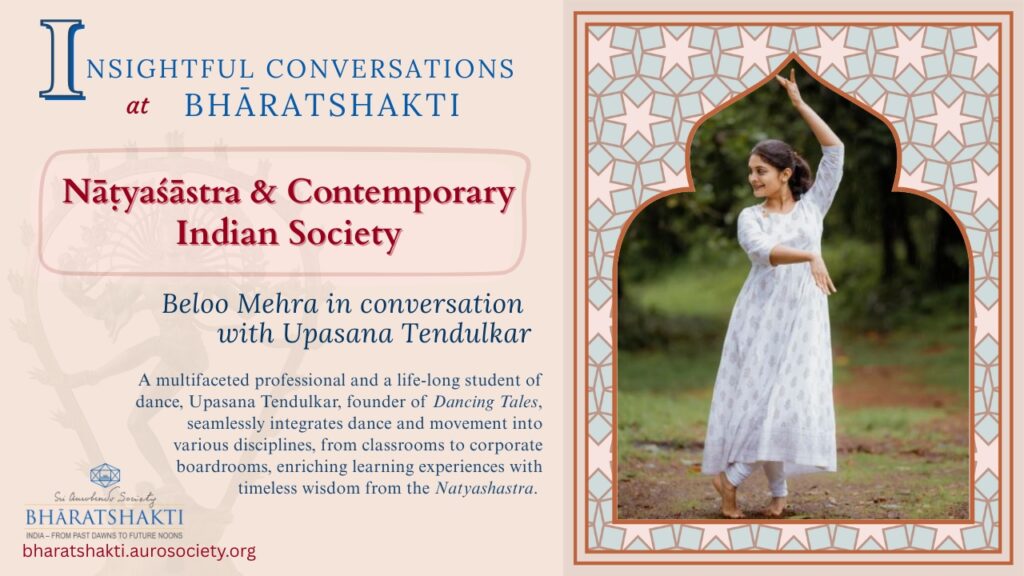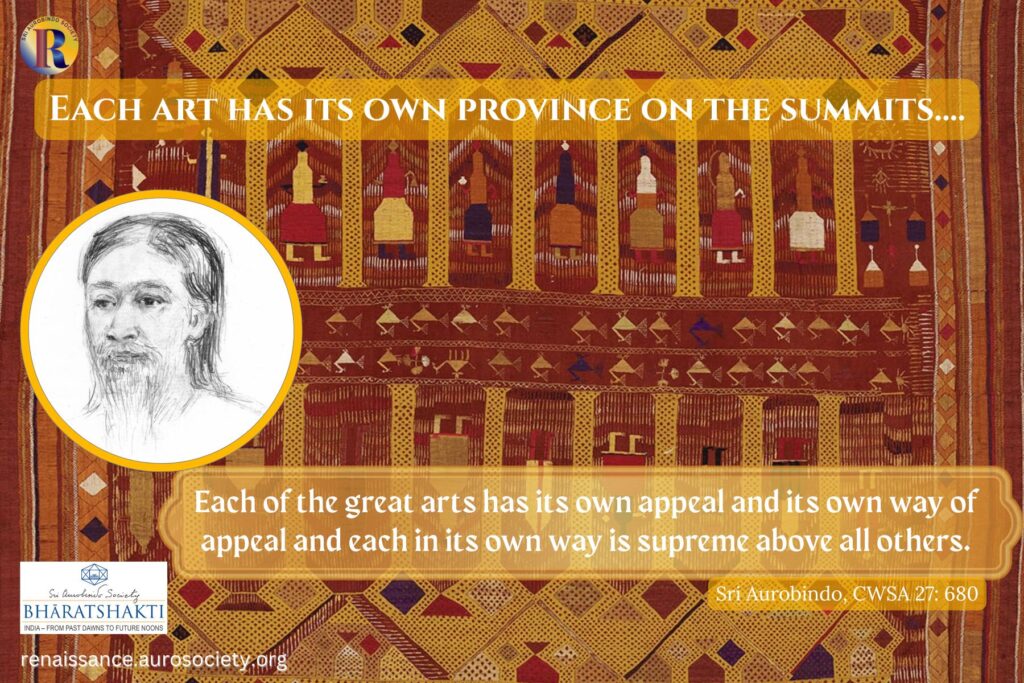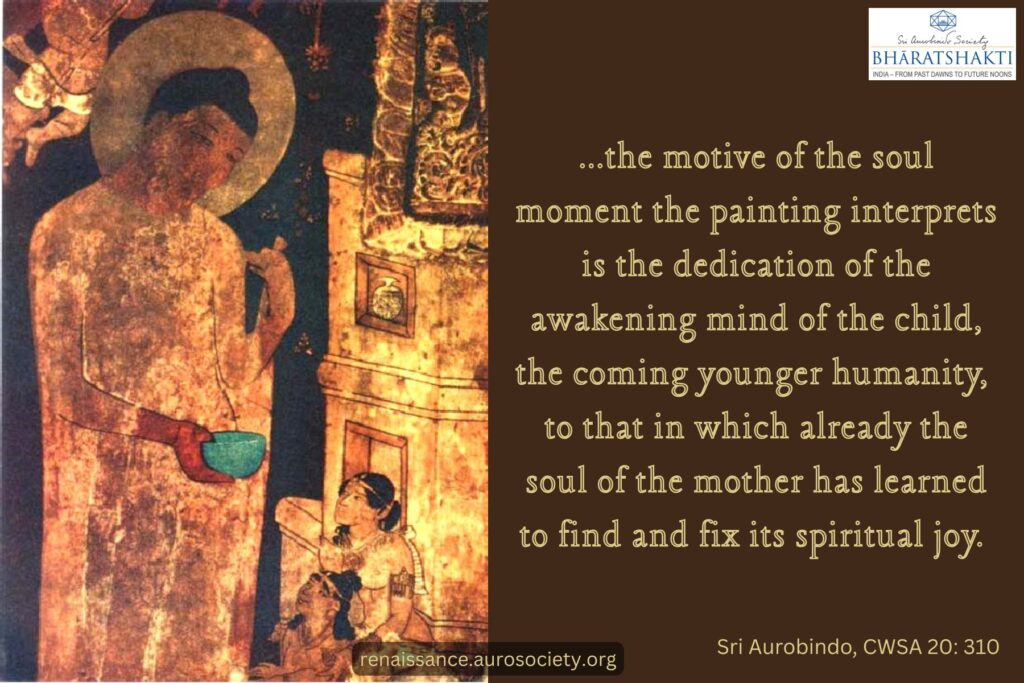Volume V, Issue 9
Author: Sri Aurobindo
Editor’s Note: What is it that we are truly seeking when we seek beauty? How can one consciously appreciate that which is beautiful and true?
Vishvanatha, the renowned 14th century scholar of Indian aesthetics, writes in Sāhitya Darpana that the experience of beauty is pure, invisible, self-manifested, compounded equality of joy and consciousness, free of admixture with any other perception, the very twin brother of mystic experience (Brahmānanda sahodarah), and the very life of it is supra-sensuous wonder. It is enjoyed by those who are competent in the art of Yoga – that is, in uniting with the Divine, just as the form of God is itself the Delight with which it is recognized.
Let us read a few excerpts from Sri Aurobindo where he uncovers the essential truth behind the relation between Beauty, Truth, Goodness, and Delight.

The Soul of Beauty
… that which we are seeking through beauty is in the end that which we are seeking through religion, the Absolute, the Divine.
The search for beauty is only in its beginning a satisfaction in the beauty of form, the beauty which appeals to the physical senses and the vital impressions, impulsions, desires. It is only in the middle a satisfaction in the beauty of the ideas seized, the emotions aroused, the perception of perfect process and harmonious combination.
Behind them the soul of beauty in us desires the contact, the revelation, the uplifting delight of an absolute beauty in all things which it feels to be present, but which neither the senses and instincts by themselves can give, though they may be its channels,—for it is suprasensuous,—nor the reason and intelligence, though they too are a channel,—for it is suprarational, supra-intellectual,—but to which through all these veils the soul itself seeks to arrive.
When it can get the touch of this universal, absolute beauty, this soul of beauty, this sense of its revelation in any slightest or greatest thing, the beauty of a flower, a form, the beauty and power of a character, an action, an event, a human life, an idea, a stroke of the brush or the chisel or a scintillation of the mind, the colours of a sunset or the grandeur of the tempest, it is then that the sense of beauty in us is really, powerfully, entirely satisfied.
It is in truth seeking, as in religion, for the Divine, the All-Beautiful in man, in nature, in life, in thought, in art; for God is Beauty and Delight hidden in the variation of his masks and forms.
When, fulfilled in our growing sense and knowledge of beauty and delight in beauty and our power for beauty, we are able to identify ourselves in soul with this Absolute and Divine in all the forms and activities of the world and shape an image of our inner and our outer life in the highest image we can perceive and embody of the All-Beautiful, then the aesthetic being in us who was born for this end, has fulfilled himself and risen to his divine consummation.
To find highest beauty is to find God; to reveal, to embody, to create, as we say, highest beauty is to bring out of our souls the living image and power of God.
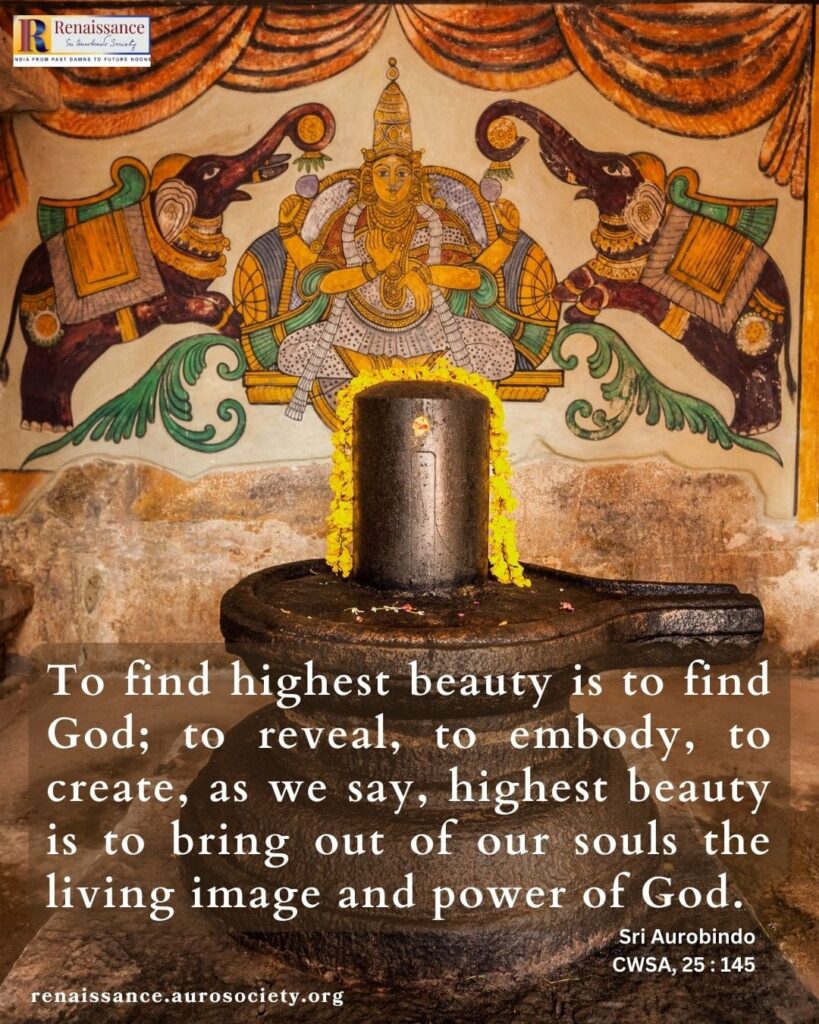
Beauty and Truth
Q: Is it not true that Beauty and Truth are always one—wherever there is Beauty there is Truth too?
In beauty there is the truth of beauty. What do you mean by Truth? There are truths of various kinds and they are not all beautiful.
10 September 1933
CWSA, Vol. 27, p. 703
***
Conscious Appreciation of Beauty
All artistic work in order to be perfect must indeed have in the very act of creation the guidance of an inner power of discrimination constantly selecting and rejecting in accordance with a principle of truth and beauty which remains always faithful to a harmony, a proportion, an intimate relation of the form to the idea; there is at the same time an exact fidelity of the idea to the spirit, nature and inner body of the thing of beauty which has been revealed to the soul and the mind, its svarūpa and svabhāva.
Therefore this discriminating inner sense rejects all that is foreign, superfluous, otiose, all that is a mere diversion distractive and deformative, excessive or defective, while it selects and finds sovereignly all that can bring out the full truth, the utter beauty, the inmost power.
But this discrimination is not that of the critical intellect, nor is the harmony, proportion, relation it observes that which can be fixed by any set law of the critical reason; it exists in the very nature and truth of the thing itself, the creation itself, in its secret inner law of beauty and harmony which can be seized by vision, not by intellectual analysis.
[…]
…the conscious appreciation of beauty reaches its height of enlightenment and enjoyment not by analysis of the beauty enjoyed or even by a right and intelligent understanding of it,—these things are only a preliminary clarifying of our first unenlightened sense of the beautiful,—but by an exaltation of the soul in which it opens itself entirely to the light and power and joy of the creation.
The soul of beauty in us identifies itself with the soul of beauty in the thing created and feels in appreciation the same divine intoxication and uplifting which the artist felt in creation.

Beauty and Goodness
In one of his recent essays, Rabindranath Tagore says that goodness and beauty are so intimately correlated that they are always found together. “The good is necessarily beautiful,” he says, and “Beauty is the picture of the good; goodness is the reality behind beauty.”
I can’t say that I understand these epigrammatic sentences. What is meant by good? what is meant by beauty? The divine Good is no doubt necessarily beautiful, because on a higher plane good and beauty and all else that is divine in origin meet, coalesce, harmonise.
But what men call good is often ugly or drab or unattractive. Human beauty is not always the picture of the good, it is sometimes the mask of evil—the reality behind that mask is not always goodness. These things are obvious, but probably Rabindranath meant good and beauty in their higher aspects or their essence.
9 September 1937
CWSA, Vol. 27, p. 703
***
Ananda of Beauty
Beauty is not the same as delight, but like Love it is an expression, a form of Ananda,—created by Ananda and composed of Ananda, it conveys to the mind that delight of which it is made. Aesthetically, the delight takes the appearance of Rasa and the enjoyment of this Rasa is the mind’s and the vital’s reaction to the perception of beauty.
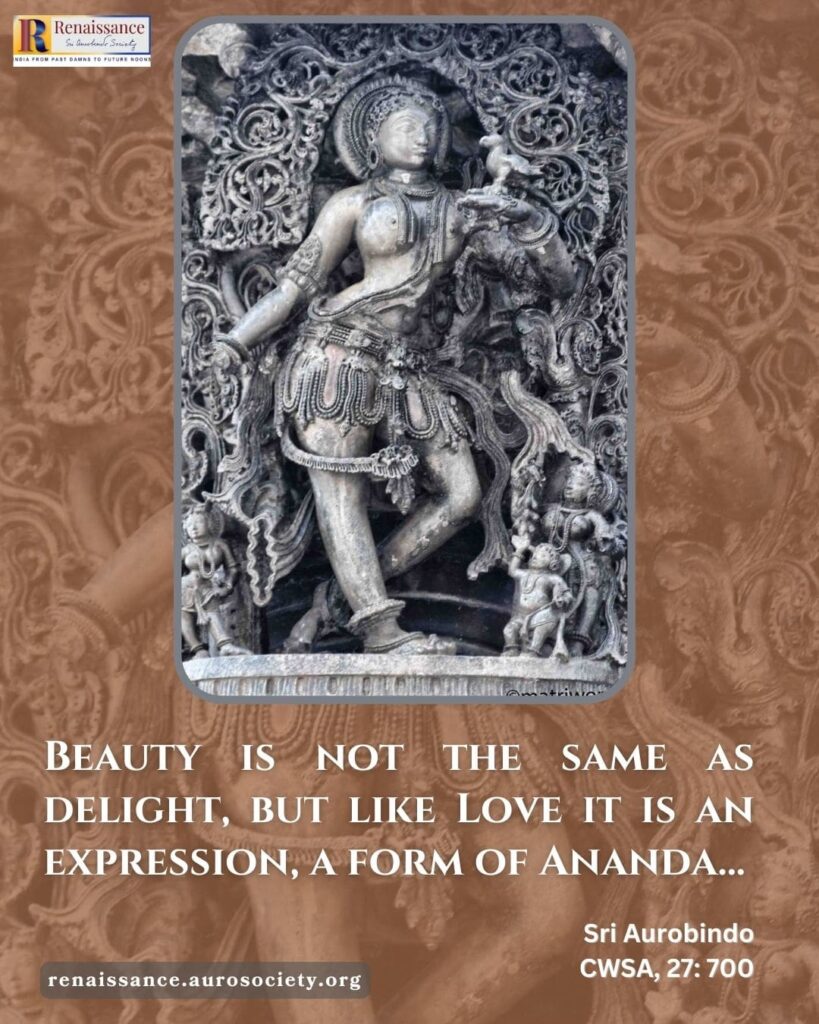
The spiritual realisation has a sight, a perception, a feeling which is not that of the mind and vital;—it passes beyond the aesthetic limit, sees the universal beauty, sees behind the object what the eye cannot see, feels what the emotion of the heart cannot feel and passes beyond Rasa and Bhoga to pure Ananda—a thing more deep, intense, rapturous than any mental or vital or any physical rasa reaction can be.
It sees the One everywhere, the Divine everywhere, the Beloved everywhere, the original bliss of existence everywhere, and all these can create an inexpressible Ananda of beauty—the beauty of the One, the beauty of the Divine, the beauty of the Beloved, the beauty of the eternal Existence in things. It can see also the beauty of forms and objects, but with a seeing other than the mind’s, other than that of a limited physical vision—what was not beautiful to the eye becomes beautiful, what was beautiful to the eye wears now a greater, marvellous and ineffable beauty.
The spiritual realisation can bring the vision and the rapture of the All-Beautiful everywhere.
26 October 1935
CWSA, Vol. 27, pp. 700-701
***
You say [in the letter of 26 October 1935, “Aesthetically, the delight takes the appearance of Rasa and the enjoyment of this Rasa is the mind’s and the vital’s reaction to the perception of beauty.” I find it hard to understand how beauty, Rasa and delight are connected with one another.
That can hardly be realised except by experience of Ananda. Ananda is not ordinary mental or vital delight in things. Rasa is the mind’s understanding of beauty and pleasure in it accompanied usually by the vital’s enjoyment of it (bhoga). Mental pleasure or vital enjoyment are not Ananda, but only derivations from the concealed universal Ananda of the Spirit in things.
7 November 1935
CWSA, Vol. 27, pp. 701-702
***
Beauty – a Power of Ananda
Love and Beauty are powers of Ananda as Light and Knowledge are of Consciousness. Force is inherent in Consciousness and may be called part of the Divine Essence. Ananda is always there even when Sachchidananda takes on an impersonal aspect or appears as the sole essential Existence; but Love needs a Lover and Beloved, Beauty needs a manifestation to show itself. So in the same way Consciousness is always there, but Knowledge needs a manifestation to be active, there must be a Knower and a Known.
That is why the distinction is made between Ananda which is of the essence and Beauty which is a power or expression of Ananda in manifestation. These are of course philosophical distinctions necessary for the mind to think about the world and the Divine.
4 November 1935
CWSA, Vol. 27, p. 701
Also read:
Tagore on The Realisation of Beauty
When Ugly becomes Beautiful
As you say, there is a truth behind Tagore’s statement.* There is such a thing as a universal Ananda and a universal beauty and the vision of it comes from an intensity of sight which sees what is hidden and more than the form—it is a sort of viśvarasa such as the Universal Spirit may have had in creating things. To this intensity of sight a thing that is ugly becomes beautiful by its fitness for expressing the significance, the guna, the rasa which it was meant to embody.
But I doubt how far one can make an aesthetic canon upon this foundation. It is so far true that an artist can out of a thing that is ugly, repellent, distorted create a form of aesthetic power, intensity, revelatory force. The murder of Duncan is certainly not an act of beauty, but Shakespeare can use it to make a great artistic masterpiece.
But we cannot go so far as to say that the intensity of an ugly thing makes it beautiful.
It is the principle of a certain kind of modern caricature to make a face intensely ugly so as to bring out some side of the character more intensely by a hideous exaggeration of lines. In doing that it may be successful, but the intensity of the ugliness it creates does not make the caricature a thing of beauty; it serves its purpose, that is all.
So too ugliness in painting must remain ugly, even if it gets out of itself a sense of vital force or expressiveness which makes it preferable in the eyes of some to real beauty. All that hits you in the midriff violently and gives you a sense of intense living is not necessarily a work of art or a thing of beauty. I am answering of course on the lines of your letter. I do not know what Tagore had precisely in view in thus defining beauty.
3 November 1936
CWSA, Vol. 27, pp. 702-703
* CWSA Editors’ note – It is not known to what “statement” Sri Aurobindo is referring here.
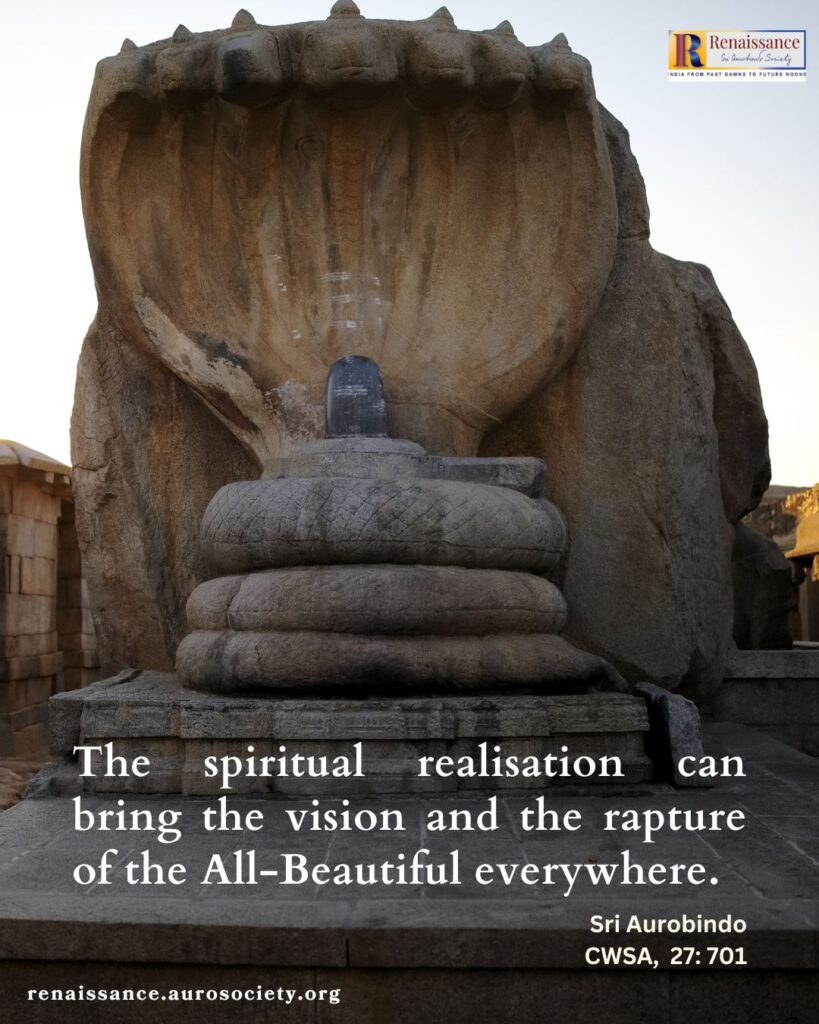
Also read:
“In India God is the All-beautiful” – Conversations with Sri Aurobindo
~ Design: Beloo Mehra

